Here is why your fiddle leaf fig is turning brown.
One of the most common questions fiddle leaf fig shop owners has been how to treat brown stains on their plant’s beautiful leaves. Finding brown spots on your fig’s magnificent large green leaves is disappointing, and the problem may be aggravating and perplexing since knowing what’s causing the brown patches on the fig leaf takes a keen eye and a little bit of effort.
Here are the reasons why your fig leaves are turning brown.
To help your fiddle leaf fig properly recover, it is vital to identify and address the problem as soon as possible. Four significant reasons contribute to brown spots:
• Rotting root systems
• Bacterial contamination
• Dry leaves
• Insect damage

What are the brown marks on a fig leave?
Fiddle’s brown areas on a fiddle-leaf fig generally indicate problem. If your fig’s leaves begin to turn brown, this signals that your plant is unwell or anxious and needs treatment. The good news is that none of the possible reasons for spots on your fig is dangerous. If detected early and treated immediately, your fig leaf has a good chance of fully recovering.
The most common reason for your fig leaves turning brown is an external or internal infection. To put it another way, plant tissue starts to die, resulting in patchy, brown leaves. This isn’t the sole explanation for brown spots on figs leaf.
They can also acquire sunburn, which seems to be a sickness. In most cases, illness in fig leaves is directly tied to their growth circumstances. Fortunately, you can rapidly adjust them and have your beautiful plant back to life. The first step is to identify the source of the brown areas on your fig leaf.
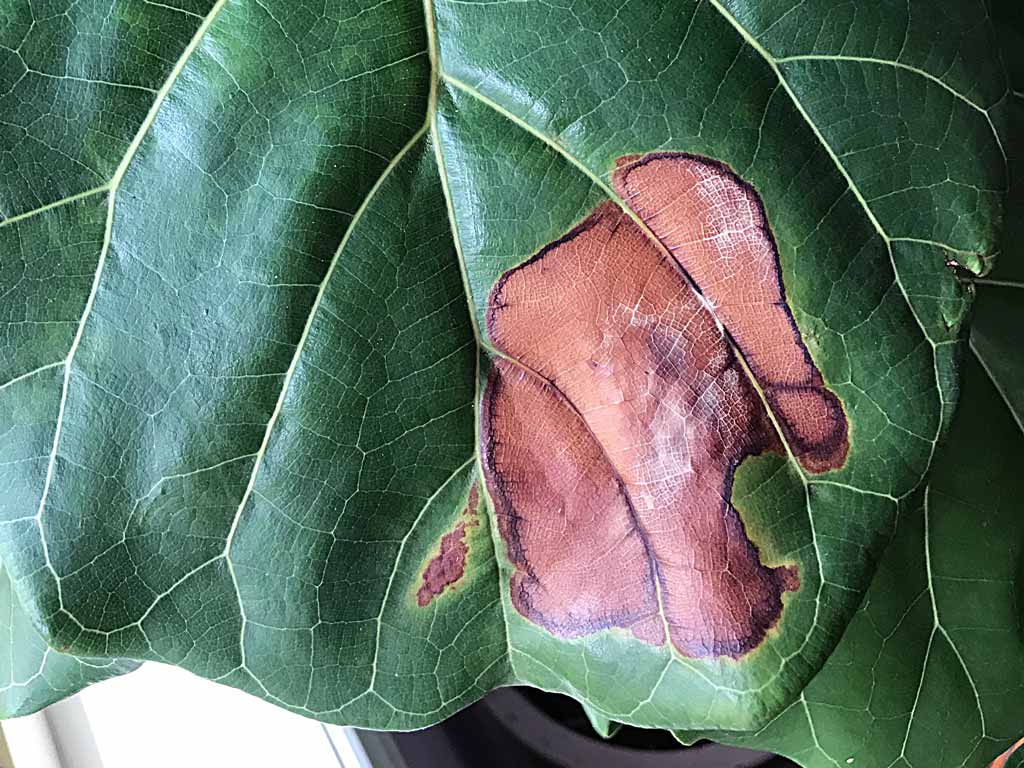
What produces brown patches on a fig leaves?
There are a few primary reasons why the fig leaves houseplant may have brown spots. These include bacterial or fungal root rot, insect infections, more sunshine, and dryness.
A thorough study of your leaves may help you pinpoint the exact problem that your plant is experiencing.
Root Rot causes fig leaves to turn brown.
Overwatering causes root rot, which is likely the most common cause of brown spots on a fig leaf.
Root rot is a fungal infection that happens when roots are submerged in water for an extended length of time without adequate drainage. A lack of sunlight might aggravate root rot illness. A container that is too big may also cause your plant’s roots to become excessively wet between water routines.
Your plant’s bottom leaves are the first to be harmed by root rot, so begin your search there. Roots of fiddle leaf figs, in particular, demand well-drained soil. Root rot is frequently treatable, especially if detected early.
Make sure you’re using a well-draining container and fast-draining potting soil and that you’re not overwatering.
The next stage will be to evaluate the damage. If your plant simply has a few brown patches on the leaves, you do not need to repot it. Allow two weeks or longer for your plant to dry out to allow the roots to recuperate. Remove any damaged leaves and make sure your plant gets enough sunlight.
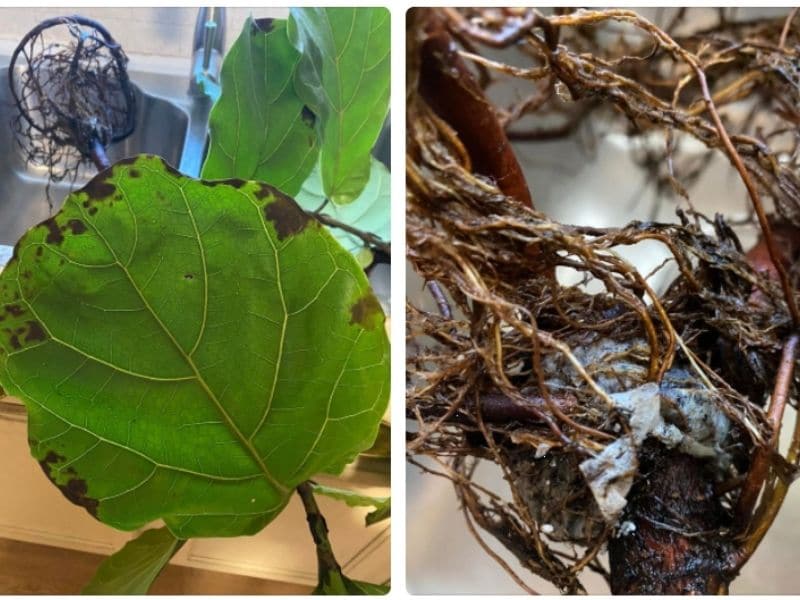
Invasion of insects causes fig leaves to turn brown.
Fig brown spots can also be created by insects, although small holes in the leaves commonly accompany them. To spot an insect infestation, look for indications of little insects crawling over your plant, as well as remaining webs or eggs.
Dealing with an insect infestation may be a simple process since removing the bugs, and damaged leaf detritus should cure the problem. Insect spots are lighter in color than root rot spots and do not spread on their own.
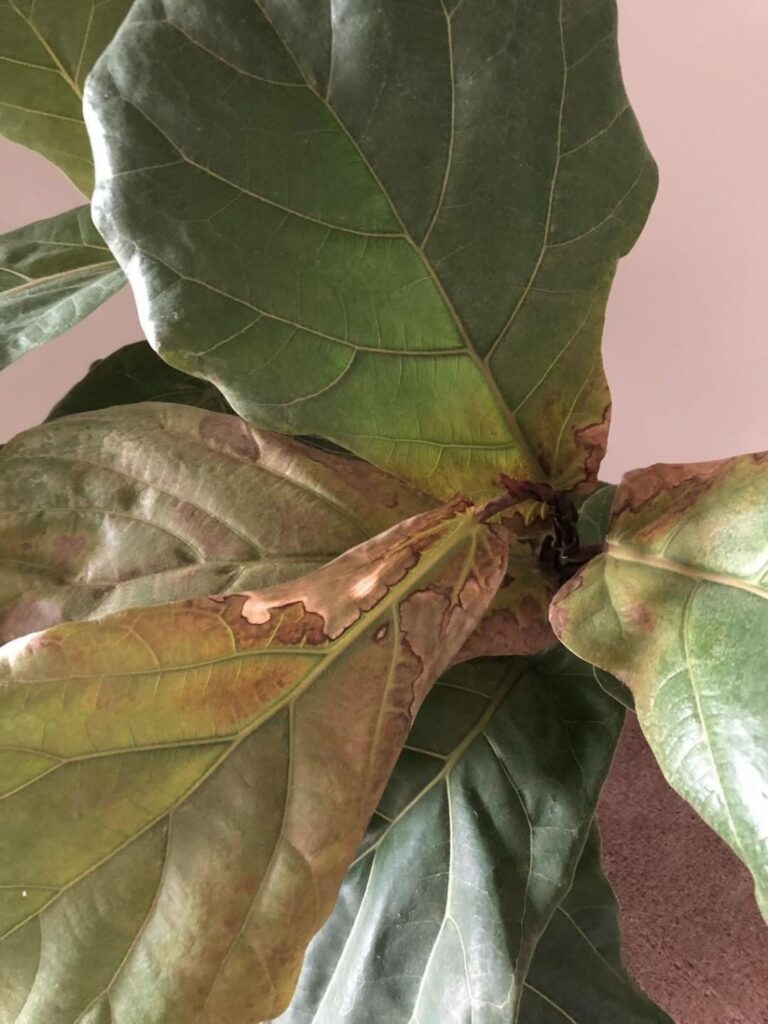
Bacterial Infection in Figs causes brown leaves.
Bacterial root rot shows as irregular dark brown spots along the leaf margins of your fig. Bacterial root rot is caused by overwatered or waterlogged soil, which is mainly caused by insufficient drainage and aeration. The goal is to address afflicted regions as soon as possible before the damage becomes too severe. The treatment is similar to that of root rot: ensure that the roots of your plant dry out between waterings and that it receives plenty of sunlight.
Remove all of the leaves with brown spots and repot your plant in a container with appropriate drainage and fresh, sterile soil if the damage is minor. Allow it plenty of light and water sparingly till it heals. Fresh air also helps in this case!
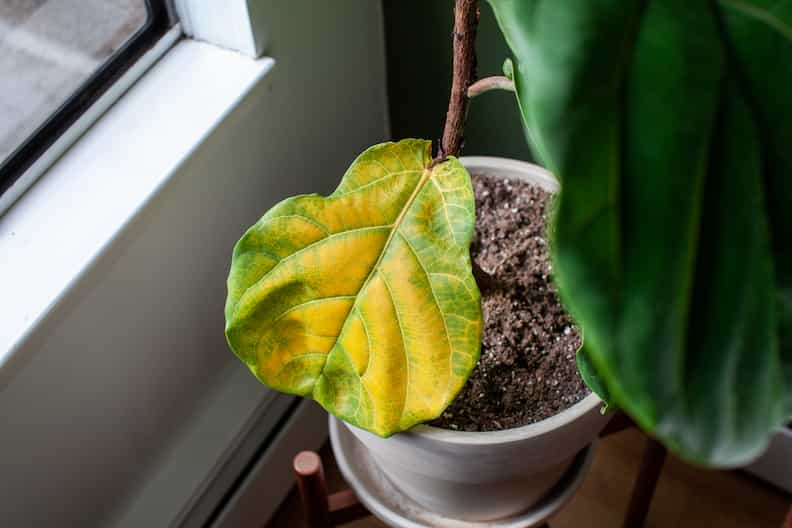
Dryness causes brown spots on Fig leaf.
Parched fig leaf plants can soon develop brown spots that are tanner than brown in color and start at the leaf’s edge and travel within.
Your plant’s relative humidity should be between 30-65%; therefore, if your home humidity is significantly lower or your plant, you may need to mist or move it to produce extra humidity for your fig plant. The most basic treatment for a dry plant is to keep it from drowning and having a proper watering routine. Water your plant just until the top inch of soil has dried up. If you see soil shrinkage, repot your plant to ensure the root receives adequate water.
Repotting is simple, and just a few actions are required to ensure success for your houseplants. Water your fiddle leaf fig plant on a regular basis and keep an eye on fiddle leaf to ensure it gets enough water.
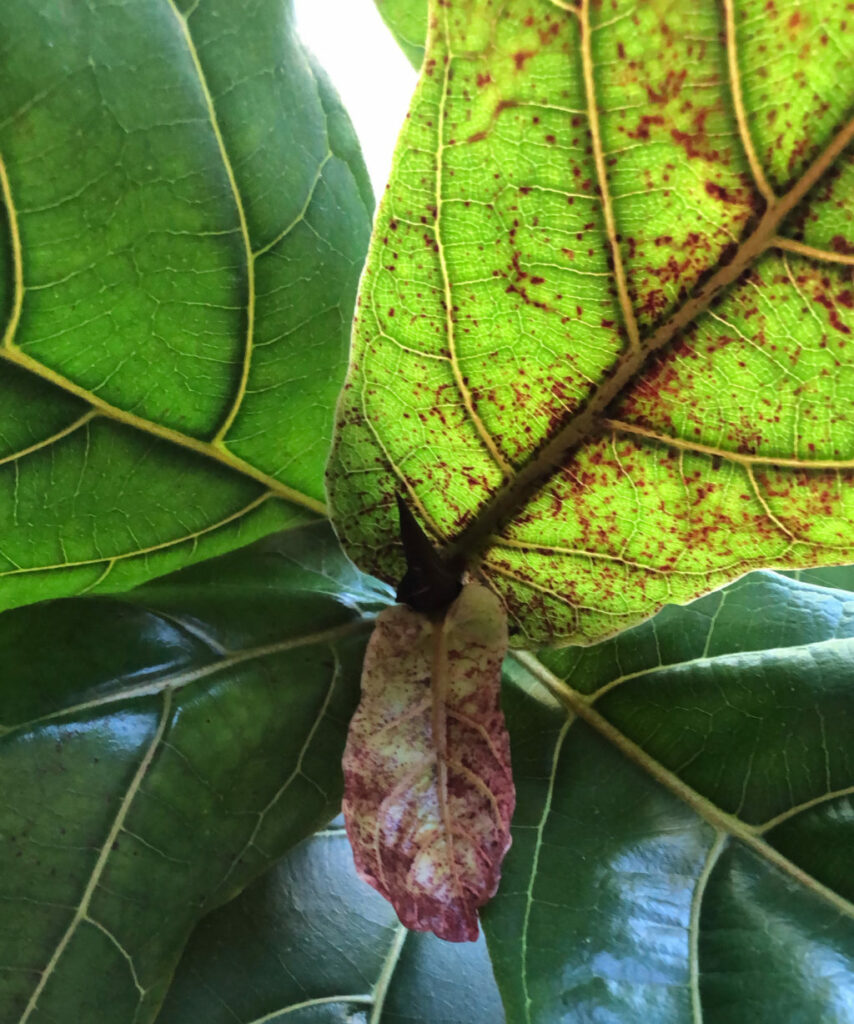
Sunburn causes your fig’s leaves to turn brown.
If you expose your indoor fig suddenly to a lot of sunshine, your fig leaves might acquire sunburn. While this is not very common, it does occur and shows as light-tan spots on your plant’s upper outer leaves.
The size of sunburned areas of fiddle leaf fig leaves can range differently, depending on how much exposure the plant has received. The burned edges will not recover, but they may be removed without causing more damage to the plant.
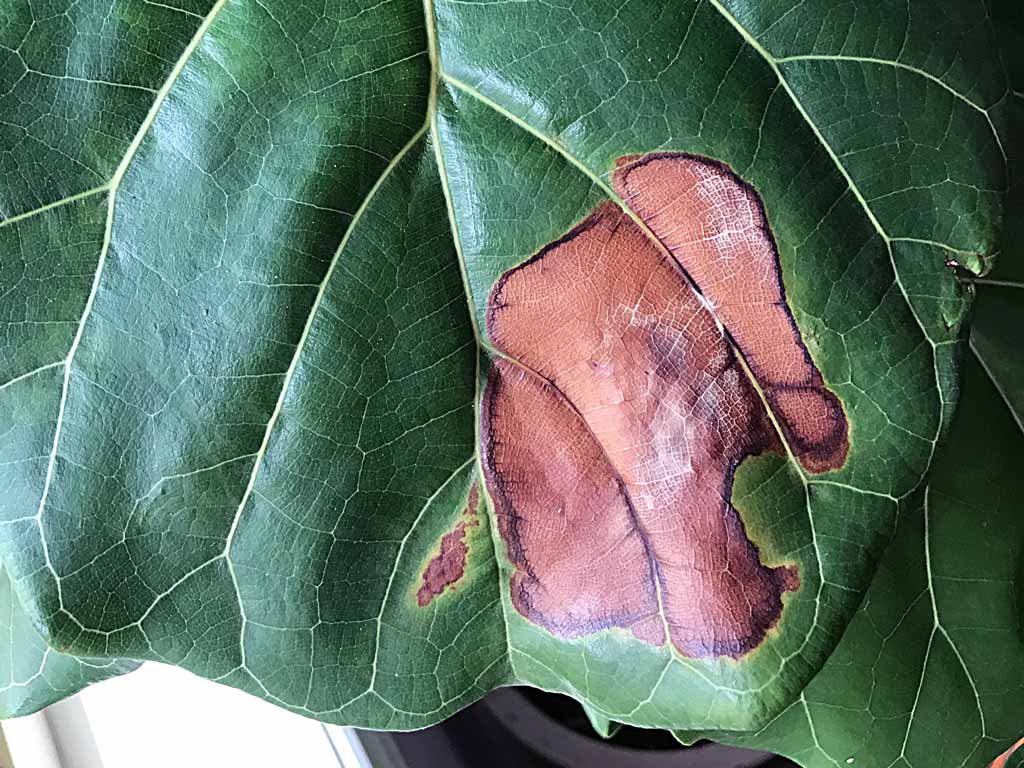
Illness or bruising of the leaves.
Sometimes brown spots on your fig, might be caused by leaf bruising or by a leaf-specific disease, such as bacterial leaf spot.
In this case, you can spot brown patches usually on yellow fiddle leaf figs. The yellowing of the leaves is visible and precedes the brown spots that follow.
Spray with fertilizers on fiddle leaf fig’s plant to stop them from turning brown. Spray the underside of each leaf, giving careful attention to where the leaf meets the stem. Wait two weeks before examining again and, if required, repeating the spraying process.
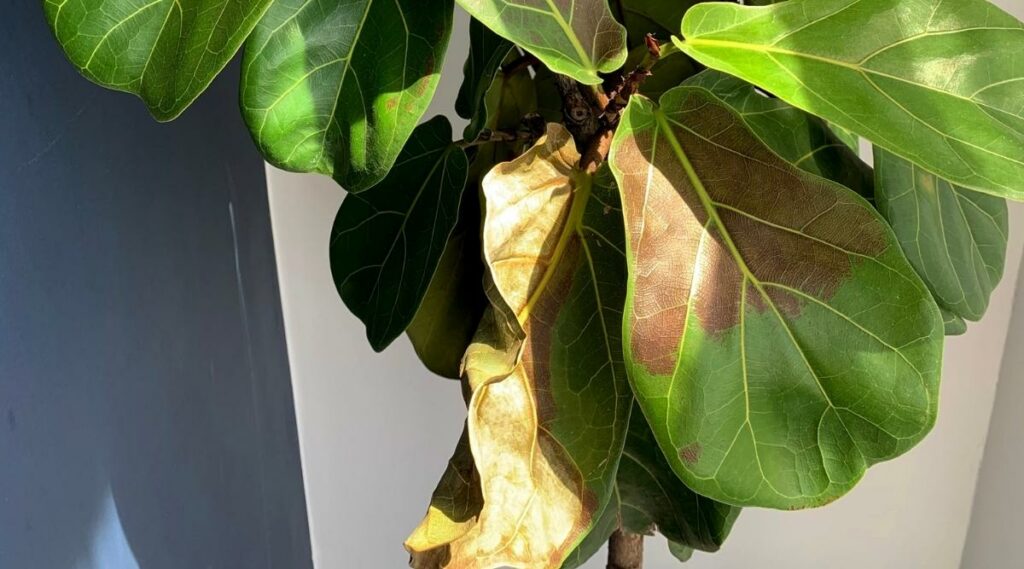
What should you do if there are brown spots on your fig leaf?
Once you’ve identified the source of your fiddle leaf brown spots, you’ll want to treat the issue as quickly as possible so that your plant may fully recover. Here are some tips to save your houseplants:
• Fix your irrigation difficulties to avoid the recurrence of brown areas.
• Use a fast-draining soil
• Make sure your plant receives adequate sunlight for food
• Fertilize appropriately
• Inspect your plant on a regular basis
While fig leaves are relatively resistant, keep an eye out for any disease symptoms to fix the problem. Fiddle leaf fig brown spots on your plant might suggest a variety of issues with your plant and if left untreated, your fig leaves may fall off, inflicting irreversible damage to your plants’ health.
